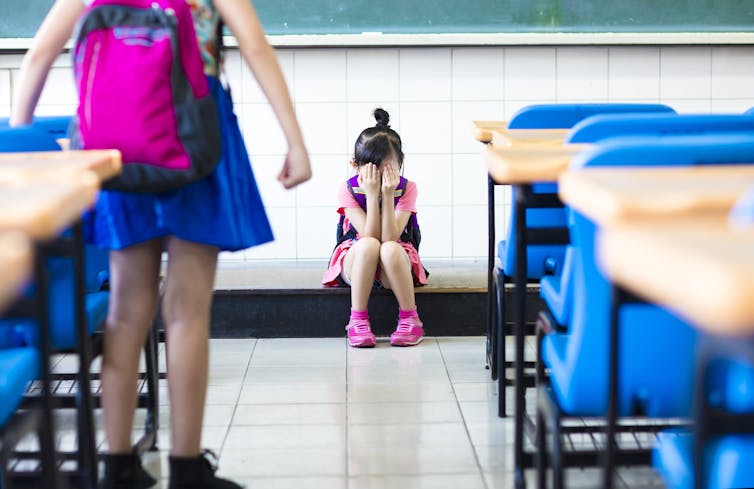- The COVID-19 has resulted in schools shut all across the world. Globally, over 1.2 billion children are out of the classroom.
- As a result, education has changed dramatically, with the distinctive rise of e-learning, whereby teaching is undertaken remotely and on digital platforms.
- Research suggests that online learning has been shown to increase retention of information, and take less time, meaning the changes coronavirus have caused might be here to stay.
While countries are at different points in their COVID-19 infection rates, worldwide there are currently more than 1.2 billion children in 186 countries affected by school closures due to the pandemic. In Denmark, children up to the age of 11 are returning to nurseries and schools after initially closing on 12 March, but in South Korea students are responding to roll calls from their teachers online
With this sudden shift away from the classroom in many parts of the globe, some are wondering whether the adoption of online learning will continue to persist post-pandemic, and how such a shift would impact the worldwide education market.
Even before COVID-19, there was already high growth and adoption in education technology, with global edtech investments reaching US$18.66 billion in 2019 and the overall market for online education projected to reach $350 Billion by 2025. Whether it is language apps, virtual tutoring, video conferencing tools, or online learning software, there has been a significant surge in usage since COVID-19.
How is the education sector responding to COVID-19?
In response to significant demand, many online learning platforms are offering free access to their services, including platforms like BYJU’S, a Bangalore-based educational technology and online tutoring firm founded in 2011, which is now the world’s most highly valued edtech company. Since announcing free live classes on its Think and Learn app, BYJU’s has seen a 200% increase in the number of new students using its product, according to Mrinal Mohit, the company's Chief Operating Officer.
Tencent classroom, meanwhile, has been used extensively since mid-February after the Chinese government instructed a quarter of a billion full-time students to resume their studies through online platforms. This resulted in the largest “online movement” in the history of education with approximately 730,000, or 81% of K-12 students, attending classes via the Tencent K-12 Online School in Wuhan.
Other companies are bolstering capabilities to provide a one-stop shop for teachers and students. For example, Lark, a Singapore-based collaboration suite initially developed by ByteDance as an internal tool to meet its own exponential growth, began offering teachers and students unlimited video conferencing time, auto-translation capabilities, real-time co-editing of project work, and smart calendar scheduling, amongst other features. To do so quickly and in a time of crisis, Lark ramped up its global server infrastructure and engineering capabilities to ensure reliable connectivity.
Alibaba’s distance learning solution, DingTalk, had to prepare for a similar influx: “To support large-scale remote work, the platform tapped Alibaba Cloud to deploy more than 100,000 new cloud servers in just two hours last month – setting a new record for rapid capacity expansion,” according to DingTalk CEO, Chen Hang.
Some school districts are forming unique partnerships, like the one between The Los Angeles Unified School District and PBS SoCal/KCET to offer local educational broadcasts, with separate channels focused on different ages, and a range of digital options. Media organizations such as the BBC are also powering virtual learning; Bitesize Daily, launched on 20 April, is offering 14 weeks of curriculum-based learning for kids across the UK with celebrities like Manchester City footballer Sergio Aguero teaching some of the content.

What does this mean for the future of learning?
While some believe that the unplanned and rapid move to online learning – with no training, insufficient bandwidth, and little preparation – will result in a poor user experience that is unconducive to sustained growth, others believe that a new hybrid model of education will emerge, with significant benefits. “I believe that the integration of information technology in education will be further accelerated and that online education will eventually become an integral component of school education,“ says Wang Tao, Vice President of Tencent Cloud and Vice President of Tencent Education.
There have already been successful transitions amongst many universities. For example, Zhejiang University managed to get more than 5,000 courses online just two weeks into the transition using “DingTalk ZJU”. The Imperial College London started offering a course on the science of coronavirus, which is now the most enrolled class launched in 2020 on Coursera.
Many are already touting the benefits: Dr Amjad, a Professor at The University of Jordan who has been using Lark to teach his students says, “It has changed the way of teaching. It enables me to reach out to my students more efficiently and effectively through chat groups, video meetings, voting and also document sharing, especially during this pandemic. My students also find it is easier to communicate on Lark. I will stick to Lark even after coronavirus, I believe traditional offline learning and e-learning can go hand by hand."
The challenges of online learning
There are, however, challenges to overcome. Some students without reliable internet access and/or technology struggle to participate in digital learning; this gap is seen across countries and between income brackets within countries. For example, whilst 95% of students in Switzerland, Norway, and Austria have a computer to use for their schoolwork, only 34% in Indonesia do, according to OECD data.
In the US, there is a significant gap between those from privileged and disadvantaged backgrounds: whilst virtually all 15-year-olds from a privileged background said they had a computer to work on, nearly 25% of those from disadvantaged backgrounds did not. While some schools and governments have been providing digital equipment to students in need, such as in New South Wales, Australia, many are still concerned that the pandemic will widenthe digital divide.
Is learning online as effective?
For those who do have access to the right technology, there is evidence that learning online can be more effective in a number of ways. Some research shows that on average, students retain 25-60% more material when learning online compared to only 8-10% in a classroom. This is mostly due to the students being able to learn faster online; e-learning requires 40-60% less time to learn than in a traditional classroom setting because students can learn at their own pace, going back and re-reading, skipping, or accelerating through concepts as they choose.
Nevertheless, the effectiveness of online learning varies amongst age groups. The general consensus on children, especially younger ones, is that a structured environment is required, because kids are more easily distracted. To get the full benefit of online learning, there needs to be a concerted effort to provide this structure and go beyond replicating a physical class/lecture through video capabilities, instead, using a range of collaboration tools and engagement methods that promote “inclusion, personalization and intelligence”, according to Dowson Tong, Senior Executive Vice President of Tencent and President of its Cloud and Smart Industries Group.
Since studies have shown that children extensively use their senses to learn, making learning fun and effective through use of technology is crucial, according to BYJU's Mrinal Mohit. “Over a period, we have observed that clever integration of games has demonstrated higher engagement and increased motivation towards learning especially among younger students, making them truly fall in love with learning”, he says.
A changing education imperative
It is clear that this pandemic has utterly disrupted an education system that many assert was already losing its relevance. In his book, 21 Lessons for the 21st Century, scholar Yuval Noah Harari outlines how schools continue to focus on traditional academic skills and rote learning, rather than on skills such as critical thinking and adaptability, which will be more important for success in the future. Could the move to online learning be the catalyst to create a new, more effective method of educating students? While some worry that the hasty nature of the transition online may have hindered this goal, others plan to make e-learning part of their ‘new normal’ after experiencing the benefits first-hand.
The importance of disseminating knowledge is highlighted through COVID-19
Major world events are often an inflection point for rapid innovation – a clear example is the rise of e-commerce post-SARS. While we have yet to see whether this will apply to e-learning post-COVID-19, it is one of the few sectors where investment has not dried up. What has been made clear through this pandemic is the importance of disseminating knowledge across borders, companies, and all parts of society. If online learning technology can play a role here, it is incumbent upon all of us to explore its full potential.
29 April 2020






















